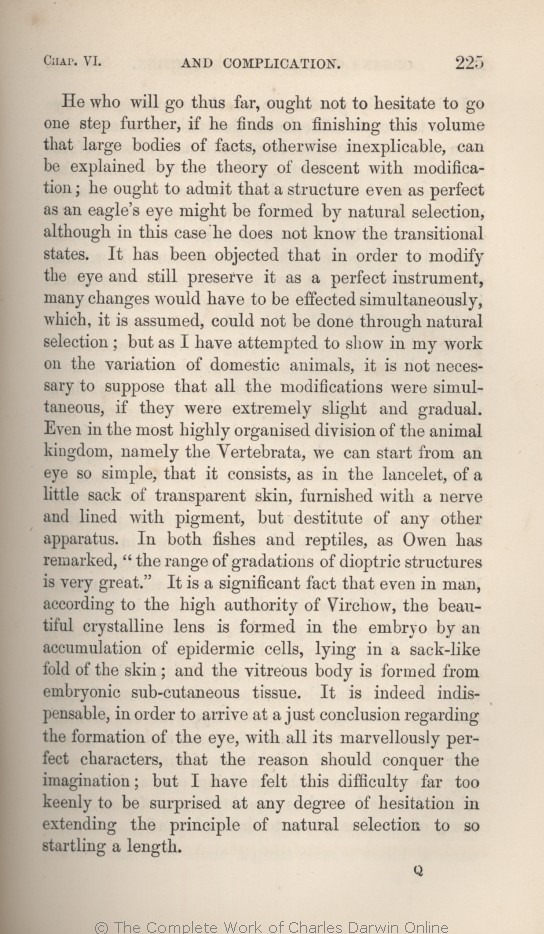He who will go thus far,
ought not to hesitate to go one step further, if | ought not to hesitate to go one step further, if 1869 1872 |
| if 1859 1860 1861 1866 |
| finds 1869 1872 | | find 1859 1860 1861 | | should find 1866 |
| volume 1866 1869 1872 | | treatise 1859 1860 1861 |
| descent with modification; he ought 1869 |
| descent, ought not to hesitate to go further, and 1859 1860 1861 |
| descent with modification, ought not to hesitate to go further, and 1866 |
| modification through natural selection; he ought 1872 |
| OMIT 1869 1872 |
| the eye of 1859 1860 1861 1866 |
| eagles 1869 | | eagle 1859 1860 1861 1866 | | eagle's 1872 |
| eye might 1869 |
| might 1859 1860 1861 1866 |
| eye might thus 1872 |
| be 1859 1860 1861 1869 1872 | | have been 1866 |
| formed 1859 1860 1861 1866 1869 | | formed, 1872 |
| by natural selection, 1859 1860 1861 1866 1869 |
| OMIT 1872 |
| ..... 1866 1869 1872 | | any of 1859 1860 1861 |
| states. 1869 1872 | | grades. 1859 1860 1861 | | steps. 1866 |
| all the modifications were 1869 |
| the modifications were all 1872 |
| 3 blocks not present in 1859 1860 1861 1866 1869; present in 1872 | | Different kinds of modification would, also, serve for the same general purpose: as Mr. Wallace has remarked, "if a lens has too short or too long a focus, it may be amended either by an alteration of curvature, or an alteration of density; if the curvature be irregular, and the rays do not converge to a point, then any increased regularity of curvature will be an improvement.
So the contraction of the iris and the muscular movements of the eye are neither of them essential to vision, but only improvements which might have been added and perfected at any stage of the construction of the instrument." Within the highest division of the animal kingdom, namely, the Vertebrata, we can start from an eye so simple, that it consists, as in the lancelet, of a little sack of transparent skin, furnished with a nerve and lined with pigment, but destitute of any other apparatus.
In fishes and reptiles, as Owen has remarked, "the range of gradations of dioptric structures is very great." It is a significant fact that even in man, according to the high authority of Virchow, the beautiful crystalline lens is formed in the embryo by an accumulation of epidermic cells, lying in a sack-like fold of the skin; and the vitreous body is formed from embryonic sub-cutaneous tissue.
|
| OMIT 1869 |
| Vertebrata, so manifestly the 1866 |
| organised 1869 | | organized 1866 |
| namely the Vertebrata, we 1869 |
| we 1866 |
| OMIT 1869 |
| as in the former cases, 1866 |
| so simple, that it consists, as 1869 |
| such as exists 1866 |
| lancelet, 1869 |
| fish called the lancelet, which is so simple that it consists only 1866 |
| transparent skin, 1869 |
| skin, lined with pigment and 1866 |
| and lined with pigment, but 1869 |
| but 1866 |
| apparatus. 1869 | | apparatus, 1866 |
| ..... 1869 | | transparent 1866 |
| both 1869 |
| the class both of 1866 |
| ..... 1869 | | originally 1866 |
| in the embryo 1869 |
| merely 1866 |
| epidermic cells, 1869 |
| cells of the epidermis, 1866 |
| indispensable, 1869 | | indispensable 1866 |
| in order to arrive at a just conclusion regarding the 1869 |
| that the naturalist who reflects on the origin and manner of 1866 |
| characters, that the reason should conquer the imagination; but 1869 |
| attributes, should make his reason conquer his imagina- tion; though 1866 |
|









